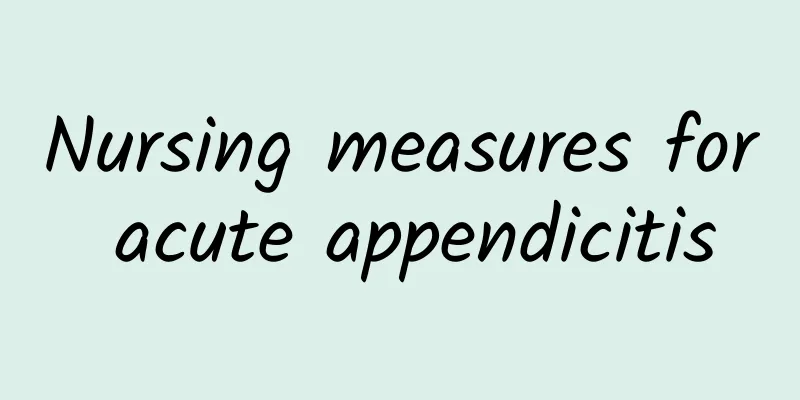Nursing measures for acute appendicitis

|
Acute appendicitis is a common disease in our lives. Many people will get sick and often undergo resection surgery. Acute appendicitis refers to an acute disease caused by obstruction, infection and inflammatory response in the appendix lumen. The disease is common between the ages of 10 and 30, but it is not limited to this age group. Nursing for acute appendicitis is crucial. Good care can not only relieve the patient's pain, but also prevent the occurrence of complications. So, today I will take you to understand the nursing measures for acute appendicitis. The typical symptoms of acute appendicitis are persistent pain in the right lower abdomen, which gradually increases in severity and sometimes causes throbbing pain, that is, the pain is aggravated by displacement or compression; patients often have fever, which can rise to above 38 degrees Celsius, or even as high as 39-40 degrees Celsius; constipation or diarrhea may occur, sometimes accompanied by mucus and blood. The symptoms of acute appendicitis may vary from person to person, and the early symptoms are often atypical and easily misdiagnosed. Therefore, patients with symptoms such as pain in the right lower abdomen, especially those accompanied by fever, nausea, vomiting, etc., should seek medical attention for examination and diagnosis in a timely manner. 1. Preoperative care According to the doctor's instructions, assist the patient in necessary laboratory tests (such as blood tests, urine tests, etc.) and imaging tests (such as ultrasound examinations, CT scans, etc.) to help the doctor make a clear diagnosis and assess the risks of the operation. Inform the patient of the time they need to fast and not drink water before the operation to avoid aspiration or other complications during the operation. Usually, they should fast for 6-8 hours before the operation to ensure that there is no content in the stomach. Introduce the surgical process, precautions, postoperative care, etc. to the patient and family members, so that they understand the importance and necessity of the operation and enhance their cooperation and confidence in the operation. 2. Intraoperative Care Assist the doctor to make necessary adjustments to ensure that the patient is in the best surgical posture. Closely monitor the patient's vital signs during the operation, including heart rate, blood pressure, respiration, etc., and promptly detect and handle any abnormalities. Strictly implement the infection control standards for the operating room, including aseptic processing of surgical instruments and disinfection of the operating room environment, to reduce the risk of intraoperative infection. 3. Postoperative Care Body position adjustment: Choose an appropriate lying position according to different anesthesia. For example, patients undergoing lumbar anesthesia should lie flat without a pillow for 6 to 12 hours. Monitor vital signs: Patients should monitor their vital signs every 4 hours after surgery, including heart rate, respiratory rate, body temperature, blood pressure, etc. Normal physiological range: heart rate 60-100 times/minute, respiratory rate 12-20 times/minute, body temperature 36.1-37.2 degrees Celsius, systolic blood pressure 90-140mmHg, diastolic blood pressure 60-90mmHg. For patients with diabetes, blood sugar levels should be closely monitored after surgery to maintain blood sugar between 7.8-10mmol/L to promote wound healing and prevent infection. Observe the postoperative recovery: Check the surgical incision every day for redness, swelling, exudation, signs of infection, etc. Urinary volume should be between 800-2000 ml within 24 hours after surgery, and pay attention to whether there is urine retention. Record the patient's flatulence every day, and the patient should pass gas at least once within 24 hours after surgery. Pain management: Intravenous opioid analgesics such as morphine may be considered in the first 24 hours after surgery, once every 4-6 hours, and the dose should be adjusted according to the VAS score (0-10 points) to maintain the pain score at 2-4 points. Fluid management: Control fluid intake to 1500-2000 ml in the first 24 hours after surgery, monitor urine output, and 30-50 ml per hour is normal. Avoid rapid infusion to prevent postoperative fluid overload leading to heart failure or pulmonary edema. Wound care: Change the dressing every day after surgery, keep the wound dry and clean, and avoid moisture. Observe the wound healing, and usually remove the stitches 7-10 days after surgery. Prevention of infection: Antibiotics such as ceftriaxone sodium (cefotaxime) can be used to prevent infection on the first day after surgery. Use according to the doctor's instructions. Keep your hands clean to avoid cross infection. Diet adjustment: fasting on the first day after surgery, and gradually resume eating from the second day, starting with liquid food such as rice soup and fruit juice, and gradually transitioning to soft food and normal diet. Promote recovery: Encourage patients to engage in moderate activity, starting with getting up and moving around, and gradually increase the amount of activity. Be careful to avoid strenuous exercise and weight-bearing activities. Emotional support: Continuously provide emotional support and psychological care to patients to help them cope with postoperative discomfort and recovery process and maintain an optimistic attitude. Regular follow-up visits: After surgery, patients and their families will be educated on their condition, including postoperative precautions, diet, medication, and regular follow-up visits, to improve their self-management abilities. Patients will be arranged to have follow-up visits 1 week, 1 month, and 3 months after surgery, and their recovery will be closely monitored. Postoperative problems will be promptly addressed to ensure smooth recovery. In short, the care of acute appendicitis is a complex and meticulous task, which requires close attention and careful care from nursing staff during and after the operation. Through correct nursing methods and rigorous operation, the occurrence of complications can be minimized and the patient's recovery can be promoted. The views in this article only represent personal opinions. Nurses should provide personalized care according to the doctor's advice and the patient's specific situation to ensure that the patient can recover smoothly. |
>>: What to do with high blood pressure? Medication + Improve your lifestyle
Recommend
What's going on down there? It feels like farting.
When a couple is having sex, as the frequency of ...
What is bleeding during intercourse?
Vaginal bleeding during women's menstrual per...
Does high blood test during pregnancy affect the baby?
Prenatal checkups can detect symptoms that are no...
Pregnant women have stretch marks on their buttocks
In fact, most pregnant women do not worry about t...
High blood sugar after childbirth
Many people worry about their high blood sugar, b...
Can I take Yinqiao tablets during breastfeeding?
In life, there are many kinds of medicines for tr...
Can I test for pregnancy if my period comes in two days?
For couples who are planning to have a baby, they...
Acupuncture and herbal medicine can save declining ovarian function
With the acceleration of the pace of life and the...
What is the best way to treat cervical hypertrophy?
Cervical hypertrophy is a common cervical disease...
What is the best medicine for women with frequent urination?
If women have symptoms of frequent urination and ...
Women should avoid the misunderstanding of blood supplementation in health care
Women are elves created with blood and energy. Fr...
What should girls eat at night without gaining weight
Losing weight is a topic that people often talk a...
What are the food treatments for breast hyperplasia?
As the real economy in modern society continues t...
Can metronidazole cure cervical erosion for the second time?
Cervical erosion is very harmful to patients. It ...
Is vulvar leukoplakia serious?
Vulvar leukoplakia is a relatively serious diseas...









